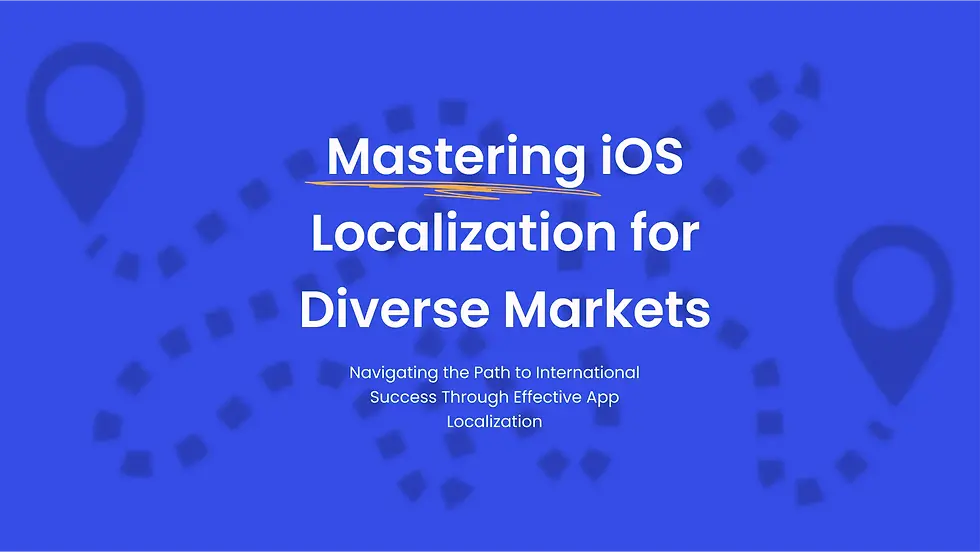Localizing iOS App for an International Audience

Localization goes beyond mere translation of your application; it requires tailoring your app to suit the cultural, technical and linguistic expectations of different regions. For iOS developers, thorough localization can substantially expand an app’s audience and boost user satisfaction, thereby influencing the product’s success. The advantages of adapting an iOS app include higher download rates, access to a wider demographic, and strengthened engagement. Additionally, localizing an app can provide a strategic edge in competitive international markets by demonstrating respect for diverse user communities. In the end, an application that is expertly localized can drive revenue growth and foster greater brand loyalty.
Understanding Localization
Localization modifies app content to align with different languages, regions and cultural contexts.
It forms a component of internationalisation, which readies software for straightforward localization.
Internationalisation encompasses structuring software to handle various languages and regional norms, whereas localization focuses on market-specific adaptation.
Localization entails adjusting digital assets and applications to suit various language, regional, and cultural requirements. This process is essential for ensuring software is accessible and functional in diverse markets worldwide. Internationalisation establishes a foundation by enabling the software to accommodate multiple languages and regional conventions without altering the core code. Localization then applies those capabilities by tailoring content specifically for each target audience. Recognising this difference is vital for developers to streamline their planning and execution of effective localization workflows.
Pre-Localization Steps
Conduct thorough market analysis to pinpoint target regions and uncover cultural preferences.
Sequence language priorities and shape content using demographic and cultural intelligence.
Strategic language choice should encompass both dominant and influential minority dialects in each locale.
Before embarking on localization, developers must undertake extensive market analysis to identify the most relevant regions and discern their linguistic and cultural nuances. This groundwork informs the prioritisation of languages and ensures that content is tailored for maximum impact. Insights into the demographics and cultural customs of each market can guide decisions around content, imagery and interface elements. Additionally, language selection should account for both the predominant language and any notable minority languages that may influence user engagement. These preparatory actions form the backbone of a localisation plan that effectively extends an app's appeal and retention overseas.
Technical Aspects of Localization
Leverage Xcode’s Base Internationalisation to streamline translation maintenance.
Organise translation entries via dedicated localizable strings files for efficient updates.
Implement support for right-to-left scripts, ensuring interface layouts adjust appropriately.
iOS developers can adopt Xcode’s Base Internationalisation feature to detach user-visible text from application code, simplifying translation workflows. This approach ensures that modifying or adding new languages does not require code-level alterations, making maintenance more straightforward. Maintaining translations within localizable strings files helps keep language assets organised and ready for updates as requirements evolve. Additionally, enabling right-to-left layout support is crucial for languages such as Arabic and Hebrew, necessitating mirrored interfaces. Attending to these technical details guarantees that the application operates correctly and respects regional linguistic conventions.
Cultural Considerations
Tailor application elements to align with regional customs, values and sensitivities.
Collaborate with native speakers or cultural consultants to validate content appropriateness.
Consider the symbolic meanings of colours, icons and numerals within each culture.
Localization transcends direct translation; it demands that developers adjust their applications to respect local traditions, beliefs and etiquette to prevent unintentional offence. Ignoring these aspects can deter prospective users and harm the app’s standing in key markets. For example, certain colours, symbols or numerical values may carry positive or negative associations depending on cultural context. Working alongside cultural experts or regional testers ensures that content resonates correctly and remains respectful. Such meticulous attention to cultural nuance can distinguish an app that feels genuinely local from one that appears foreign.
Design and UX Considerations
Modify typography and layout to support varied scripts and directional norms.
Build adaptable design systems to enhance usability in multiple locales.
Reevaluate interactive components and navigation flows for cultural intuitiveness.
When adapting designs, developers should account for script variations and bidirectional reading patterns, which may necessitate font and layout adjustments. Flexible design frameworks can greatly enhance an app’s accessibility across a wide range of languages. Certain scripts might demand larger font sizes or distinct typefaces to maintain readability, impacting overall interface structure. Moreover, interactive controls and navigation paths should be reconsidered to deliver intuitive experiences for users from diverse backgrounds. Addressing these design elements is crucial for preserving a seamless user experience and driving long-term engagement.
Testing Your Localized iOS App
Conduct region-specific testing to uncover linguistic subtleties and cultural issues.
Employ a mix of user feedback mechanisms and formal usability evaluation services.
Testing uncovers translation errors, cultural misalignments and user experience flaws.
Thorough testing is indispensable for verifying that a localized application performs correctly in each cultural environment. On-the-ground testing reveals subtleties that automated checks often overlook, guaranteeing an authentic user experience. This evaluation can expose unexpected translation inaccuracies, cultural faux pas or interface inconsistencies. Testing methodologies may include crowdsourced feedback alongside specialised usability assessments from professional agencies. Integrating comprehensive testing cycles within the localization workflow helps avoid expensive oversights and enhances product quality.
Marketing Your Localized App
Tailor marketing tactics and app store optimisation to match regional search patterns and cultural preferences.
Personalise promotional assets to resonate with local traditions and seasonal occasions.
Strategic localisation of marketing efforts boosts both acquisition rates and user loyalty.
Localised marketing plays a pivotal role in achieving traction across international markets. This entails refining app store metadata, keywords and descriptions to adhere to region-specific SEO guidelines and search behaviours. Marketing plans must align with cultural contexts to ensure messaging is engaging and meaningful. For instance, social media outreach may require customisation to coincide with local festivals or social conventions. Well-executed localisation in marketing not only elevates brand visibility but also strengthens user acquisition and retention amid global competition.
Legal and Regulatory Compliance
Familiarise with and adhere to each market’s legal and data protection requirements.
Adjust data management practices and content delivery to satisfy regulations such as GDPR or CCPA.
Address regional content restrictions and censorship mandates when distributing the app.
Every territory imposes distinct legal and privacy frameworks that must be respected. Compliance with these regulations is essential to prevent fines, litigation and reputational harm. This involves configuring data storage and processing procedures to align with laws such as the GDPR in Europe or the CCPA in North America. Developers must also remain vigilant regarding content constraints or censorship directives that could limit app features. Skillfully navigating these regulatory landscapes is key to seamless global operations.
Maintaining and Updating Localized Content
Continuously refresh localized text and assets to maintain relevance.
Solicit feedback from regional users to drive ongoing enhancements.
Sustain partnerships with localisation specialists to ensure up-to-date content.
Periodic refreshes of translated interfaces and assets are vital for preserving user interest across markets. This may require updating cultural references and refining translations to mirror linguistic shifts. Inviting local user feedback during these updates can uncover areas for enhancement and foster community engagement. Maintaining active collaboration with localisation professionals helps ensure that content remains accurate and impactful. Persistent vigilance over localized materials is fundamental to sustaining an app’s international relevance and longevity.
Tools and Resources for Localization
Utilise platforms such as Lokalise, Crowdin or Phrase for translation and project management.
Connect with developer forums for best practices and peer recommendations on localisation.
Leveraging tools and community feedback enhances both the speed and quality of localisation work.
An array of specialised tools and platforms can simplify localisation workflows, ranging from translation management systems to community-driven discussion boards. Solutions like Lokalise, Crowdin or Phrase provide collaborative environments for synchronising translations and development efforts. Engaging with developer communities who possess localisation experience offers practical advice and problem-solving tips. Combining these resources can accelerate project timelines and elevate the calibre of the localized product.
This is your Feature section paragraph. Use this space to present specific credentials, benefits or special features you offer.Velo Code Solution This is your Feature section specific credentials, benefits or special features you offer. Velo Code Solution This is
More Ios app Features
Animations in iOS: A Comprehensive Guide
Bring your UI to life with animations. This guide covers Core Animation, UIKit transitions, and SwiftUI animations to help you create interactive, delightful, and visually engaging iOS experiences.
Accessibility Advanced Techniques
Enhance your app’s accessibility with advanced techniques. Go beyond basics with custom accessibility elements, dynamic labels, and real-time adaptations. Improve your app’s usability and inclusivity for all users.



